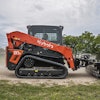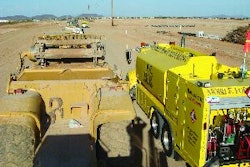DEARBORN, Mich., July 23 /PRNewswire-FirstCall/ -- Ford Motor Company (NYSE: F) today reported second quarter 2010 net income of $2.6 billion, or 61 cents per share, a $338 million improvement from second quarter 2009, as each of its major business operations around the world recorded improved profits.
Excluding special items, Ford reported a pre-tax operating profit of $2.9 billion, or 68 cents per share, an improvement of $3.5 billion from a year ago and a $932 million improvement from the prior quarter, and the company's best quarterly performance since the first quarter of 2004. Ford has posted an Automotive and total company pre-tax operating profit for four consecutive quarters.
Ford North America posted a second quarter pre-tax operating profit of $1.9 billion, a $2.8 billion improvement from second quarter 2009.
"We delivered a very strong second quarter and first half of 2010 and are ahead of where we thought we would be despite the still-challenging business conditions," said Ford President and CEO Alan Mulally. "We remain on track to deliver solid profits and positive Automotive operating-related cash flow for 2010, and we expect even better financial results in 2011.
"Our progress is being led by the strength of our new products and our leaner, global structure," Mulally added. "Customers are responding to our strongest ever product lineup - a full family of vehicles with world-class quality, fuel efficiency, safety, smart design and value."
Ford's second quarter revenue was $31.3 billion, up $4.5 billion from the same period a year ago. Excluding Volvo revenue from 2009, Ford's revenue in the second quarter was up $7.4 billion compared to 2009, or over 30 percent.
Automotive operating-related cash flow was positive $2.6 billion during the second quarter, primarily reflecting pre-tax operating profits and favorable changes in working capital.
Ford finished the second quarter with $21.9 billion in Automotive gross cash, a decrease of $3.4 billion since the first quarter, as a result of substantial debt reduction actions. Including available credit lines, total Automotive liquidity was $25.4 billion at the end of the quarter.
The company ended the second quarter with Automotive debt of $27.3 billion, down $7 billion in the quarter. The reduction included a $3.8 billion payment by Ford to the UAW Retiree Medical Benefits Trust, and a $3 billion repayment of Ford's revolving credit facility. The debt reduction will save Ford more than $470 million in annualized interest savings.
Special items were an unfavorable pre-tax amount of $95 million in the second quarter. Ford recorded $229 million of personnel and dealer-related charges related primarily to the plan to discontinue production of the Mercury brand, which was offset partially by $94 million of favorable held-for-sale adjustments for Volvo and a $40 million gain related to the full pre-payment of Ford's VEBA Note A debt obligation at a discount.
The first half cost associated with Mercury discontinuation and total U.S. dealer reductions is expected to be somewhat less than half of the total expected special item charges for these actions during the 2010 to 2011 period.
If Volvo had continued to be reported as an ongoing operation, Ford would have reported a second quarter pre-tax operating profit of $53 million for Volvo, representing a $290 million improvement compared to the second quarter of 2009.
"Our fundamental business is strong and we continue to gain momentum around the world," said Lewis Booth, Ford executive vice president and chief financial officer. "Profits improved across our global business operations in the second quarter and we made continued progress in paying down our debt and strengthening our balance sheet."
The following discussion of second quarter highlights and results are on a pre-tax basis and exclude special items. See tables following "Safe Harbor/Risk Factors" for the nature and amount of these special items and any necessary reconciliation to U.S. GAAP. Discussion of Automotive cost changes is measured primarily at prior-year exchange, and excludes special items and discontinued operations. In addition, costs that vary directly with volume, such as material, freight, and warranty costs are measured at prior-year volume and mix.
AUTOMOTIVE SECTOR
For the second quarter of 2010, Ford's worldwide Automotive sector reported a pre-tax operating profit of $2.1 billion, compared with a loss of $1.1 billion a year ago. The improvement primarily reflected favorable volume and mix, net pricing and exchange.
Total vehicle wholesales in the second quarter were 1.4 million, compared with 1.2 million units a year ago. Worldwide Automotive revenue in the second quarter was $28.8 billion, up from $23.6 billion a year ago. Wholesales, revenues and operating results for 2010 exclude Volvo, while 2009 results include Volvo.
North America: For the second quarter, Ford North America reported a pre-tax operating profit of $1.9 billion, compared with a loss of $899 million a year ago and a profit of $1.2 billion in the first quarter of 2010. The year-over-year improvement was explained primarily by favorable volume and mix, net pricing and exchange. Second quarter revenue was $16.9 billion, up from $10.7 billion a year ago.
South America: For the second quarter, Ford South America reported a pre-tax operating profit of $285 million, compared with a profit of $86 million a year ago and a profit of $203 million in the first quarter. The year-over-year increase reflects primarily favorable net pricing, favorable exchange, and higher volume, offset partially by higher commodity and structural costs. Second quarter revenue was $2.6 billion, up from $1.8 billion a year ago.
Europe: For the second quarter, Ford Europe reported a pre-tax operating profit of $322 million, compared with a profit of $57 million a year ago and a profit of $107 million in the first quarter. The year-over-year increase was explained primarily by lower costs, driven in part by lower spending related to distressed suppliers and a warranty reserve adjustment not expected to reoccur, offset partially by unfavorable net pricing. Second quarter revenue was $7.5 billion, up from $7 billion a year ago.
Asia Pacific Africa: For the second quarter, Ford Asia Pacific Africa reported a pre-tax operating profit of $113 million, compared with a loss of $27 million a year ago and a pre-tax operating profit of $23 million in the first quarter. The year-over-year improvement is more than explained by higher volume, reflecting primarily higher industry, lower costs, and favorable exchange. Second quarter revenue was $1.8 billion, up from $1.2 billion a year ago.
Other Automotive: Other Automotive consists primarily of interest and financing-related costs and resulted in a second quarter pre-tax loss of $551 million, explained by net interest expense of $459 million and $92 million of unfavorable fair market value adjustments, associated primarily with Ford's investment in Mazda.
FINANCIAL SERVICES SECTOR
For the second quarter, the Financial Services sector reported a pre-tax operating profit of $875 million, compared with a profit of $595 million a year ago.
Ford Motor Credit Company: For the second quarter, Ford Credit reported a pre-tax operating profit of $888 million compared with a profit of $646 million a year ago and a profit of $828 million in the first quarter. The year-over-year increase reflected primarily a lower provision for credit losses and lower residual losses due to higher auction values, offset partially by the non-recurrence of prior year net gains related to unhedged currency exposures and lower volume.
OUTLOOK
Ford said it continues to make progress on all four pillars of its plan:
-- Aggressively restructuring to operate profitably at the current demand and changing model mix
-- Accelerating the development of new products that customers want and value
-- Financing the plan and improving the balance sheet
-- Working together effectively as one team, leveraging Ford's global assets
Ford expects third quarter 2010 production to be up 126,000 units compared with year-ago levels, reflecting continued strong demand for Ford products, maintenance of competitive stock levels, and the non-recurrence of prior-year stock reductions. Third quarter production will be down 174,000 units compared to second quarter 2010 production, reflecting planned vacation shutdowns during the third quarter that generally are used to prepare for new models.
Fourth quarter production also will be affected by planned holiday shutdowns and new product changeovers for vehicles such as Focus and Explorer. Overall, Ford's third and fourth quarter production schedule is lower than the first half but consistent with the company's strategy to match supply with demand.
Ford expects full-year 2010 U.S. industry volume will be in the range of 11.5 million to 12 million units. In the 19 markets Ford tracks in Europe, full-year industry volume is expected to be in the 14.5 million to 15 million unit range, reflecting a stronger-than-expected first half offset by a weaker second half.
Ford now expects full-year 2010 U.S. total market share and its share of the U.S. retail market to be improved compared with 2009. Europe market share for the full year is now expected to be about equal to the first half of 2010, but lower than 2009, reflecting the company's decision to limit increases in incentives in the region.
Ford is on track to improve full-year quality for all regions, compared with a year ago.
Ford has achieved significant structural cost reductions over the past four years. In 2010, Ford expects full-year Automotive structural costs to be about $1 billion higher to support growth and key product introductions. Ford's cost structure, however, continues to improve as a percentage of revenue. Ford also expects full-year commodity costs to increase by about $1 billion.
Capital expenditures were $1.9 billion in the first half. Ford expects full-year capital spending to be about $4.5 billion to support its product plan, as the company continues to realize efficiencies from its global product development processes.
Ford Credit now expects full-year 2010 profits to be higher than its 2009 profits. The second half of 2010, will be lower than the first half because Ford Credit expects smaller improvements in the provision for credit losses and depreciation expense for leased vehicles compared with the improvements during the first half.
Ford expects to have solid financial results in the second half, continuing to exceed the expectations it had earlier this year.
As in most years, Ford's first half results will be stronger than second half, reflecting normal seasonality - including lower second half volumes related to planned shutdowns and product launches. This year, Ford also expects higher investment and costs in the second half to support growth and key product introductions, as well as higher commodity costs and smaller reductions in reserves at Ford Credit.
Overall, Ford is on track to deliver solid profits and positive Automotive operating-related cash flow for 2010, providing a solid foundation for continuing growth.
2011 Outlook
For 2011, based on present planning assumptions, Ford expects continued improvement in total company profitability and Automotive operating-related cash flow, including improvements in its Automotive operations. These improvements are driven primarily by the growing strength of Ford's global products, continued cost structure improvements and the gradually strengthening global economy.
Ford Credit will continue to be solidly profitable for 2011 but at a lower level than 2010, reflecting primarily a lower occurrence of this year's favorable factors.
By the end of 2011, Ford expects to move from a net Automotive debt position to a net cash position.
Overall, Ford said its performance gives it great confidence going forward. It has aggressively restructured its business to be profitable in the current environment and, going forward, it will continue to:
-- Expand its business, particularly in the growth regions of the world, such as China and India
-- Improve its overall cost structure and achieve competitive costs while strengthening further its operational excellence
-- Take actions to strengthen its balance sheet and become investment grade
"Our business performance this year and the growing success of our products give us great confidence going forward," Mulally said. "Our plan is to continue to enhance our operational excellence and improve our competitiveness to continue to deliver profitable growth for everyone associated with Ford."
* Includes medium and heavy trucks
** European 19 markets we track
*** Structural cost changes are measured primarily at prior-year exchange, and exclude special items and discontinued operations
**** Estimate
Ford Motor Company, a global automotive industry leader based in Dearborn, Mich., manufactures or distributes automobiles across six continents. With about 178,000 employees and about 80 plants worldwide, the company's automotive brands include Ford, Lincoln and Mercury, production of which has been announced by the company to be ending in the fourth quarter of 2010, and, until its sale, Volvo. The company provides financial services through Ford Motor Credit Company. For more information regarding Ford's products, please visit www.ford.com.
The financial results discussed herein are presented on a preliminary basis; final data will be included in Ford's Quarterly Report on Form 10-Q for the quarter ended June 30, 2010. As a result of Ford's agreement to sell Volvo, 2010 results for Volvo are being reported as special items and excluded from operating results; 2009 operating results include Volvo unless otherwise indicated. As disclosed last quarter, the new accounting standard for variable interest entity consolidation, effective Jan. 1, 2010, required Ford to deconsolidate many of its joint ventures. In addition to results in the second quarter of 2010 reflecting this new standard, 2009 results have been adjusted to reflect the deconsolidation of many of Ford's joint ventures, with Ford's joint venture in Turkey, Ford Otosan, being the most significant. For wholesale unit sales and production volumes, amounts include the sale or production of Ford-brand and JMC-brand vehicles by unconsolidated affiliates. JMC refers to our Chinese joint venture, Jiangling Motors Corporation. See materials supporting the July 23, 2010 conference calls at www.shareholder.ford.com for discussion of wholesale unit volumes. Discussion of overall Automotive cost changes is at constant exchange and excludes special items and discontinued operations; in addition, costs that vary directly with production volume, such as material, freight, and warranty costs, are measured at constant volume and mix (generally, by holding constant prior-year levels). See tables following the "Safe Harbor/Risk Factors" for the nature and amount of special items, and reconciliation of items designated as "excluding special items" to U.S. generally accepted accounting principles ("GAAP"). Also see the tables following "Safe Harbor/Risks Factors" reconciliation of Automotive gross cash and operating-related cash + flow to GAAP.
++ Excluding special items. Excluding special items and "Income/(Loss) attributable to non- controlling interests." See tables following "Safe Harbor/Risk Factors" for the nature and amount of these special items and +++ reconciliation to GAAP.
Safe Harbor/Risk Factors
Statements included herein may constitute "forward-looking statements" within the meaning of the Private Securities Litigation Reform Act of 1995. Forward-looking statements are based on expectations, forecasts, and assumptions by our management and involve a number of risks, uncertainties, and other factors that could cause actual results to differ materially from those stated, including, without limitation:
-- Further declines in industry sales volume, particularly in the United States or Europe, due to financial crisis, recession, geo-political events, or other factors; -- Decline in market share; -- Lower-than-anticipated market acceptance of new or existing products; -- An increase in or acceleration of market shift beyond our current planning assumptions from sales of trucks, medium- and large-sized utilities, or other more profitable vehicles, particularly in the United States; -- A return to elevated gasoline prices, as well as the potential for volatile prices or reduced availability; -- Continued or increased price competition resulting from industry overcapacity, currency fluctuations, or other factors; -- Adverse effects from the bankruptcy, insolvency, or government-funded restructuring of, change in ownership or control of, or alliances entered into by a major competitor; -- A prolonged disruption of the debt and securitization markets; -- Fluctuations in foreign currency exchange rates, commodity prices, and interest rates; -- Economic distress of suppliers that may require us to provide substantial financial support or take other measures to ensure supplies of components or materials and could increase our costs, affect our liquidity, or cause production disruptions; -- Single-source supply of components or materials; -- Labor or other constraints on our ability to restructure our business; -- Work stoppages at Ford or supplier facilities or other interruptions of production; -- Substantial pension and postretirement health care and life insurance liabilities impairing our liquidity or financial condition; -- Worse-than-assumed economic and demographic experience for our postretirement benefit plans (e.g., discount rates or investment returns); -- Restriction on use of tax attributes from tax law "ownership change;" -- The discovery of defects in vehicles resulting in delays in new model launches, recall campaigns, or increased warranty costs; -- Increased safety, emissions, fuel economy, or other regulation resulting in higher costs, cash expenditures, and/or sales restrictions; -- Unusual or significant litigation or governmental investigations arising out of alleged defects in our products, perceived environmental impacts, or otherwise; -- A change in our requirements for parts or materials where we have long-term supply arrangements that commit us to purchase minimum or fixed quantities of certain parts or materials, or to pay a minimum amount to the seller ("take-or-pay" contracts); -- Adverse effects on our results from a decrease in or cessation of government incentives related to capital investments; -- Adverse effects on our operations resulting from certain geo-political or other events; -- Substantial levels of Automotive indebtedness adversely affecting our financial condition or preventing us from fulfilling our debt obligations (which may grow because we are able to incur substantially more debt, including additional secured debt); -- Failure of financial institutions to fulfill commitments under committed credit facilities; -- Inability of Ford Credit to obtain competitive funding; -- Inability of Ford Credit to access debt, securitization, or derivative markets around the world at competitive rates or in sufficient amounts due to credit rating downgrades, market volatility, market disruption, regulatory requirements or other factors; -- Higher-than-expected credit losses; -- Increased competition from banks or other financial institutions seeking to increase their share of financing Ford vehicles; -- Collection and servicing problems related to finance receivables and net investment in operating leases; -- Lower-than-anticipated residual values or higher-than-expected return volumes for leased vehicles; and -- New or increased credit, consumer, or data protection or other regulations resulting in higher costs and/or additional financing restrictions.
We cannot be certain that any expectation, forecast, or assumption made in preparing forward-looking statements will prove accurate, or that any projection will be realized. It is to be expected that there may be differences between projected and actual results. Our forward-looking statements speak only as of the date of their initial issuance, and we do not undertake any obligation to update or revise publicly any forward-looking statement, whether as a result of new information, future events or otherwise. For additional discussion of these risks, see "Item 1A. Risk Factors" in our 2009 Form 10-K Report.


















